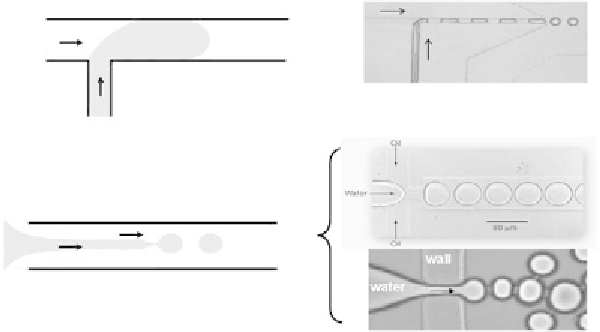Biomedical Engineering Reference
In-Depth Information
Two different systems corresponding to two types of instabilities are used to
create microdrops in a microflow. The first type of instability occurs in T-junctions
at a low velocity—small Capillary and Weber numbers—where the detachment
of a droplet is governed by the pressure drop created by the merging droplet
[Figure 4.54(a)]. This phenomenon is called squeezing. The second type is obtained
in FFDs and T-junctions with a higher flow velocity, where a flowing liquid is re-
duced to a filament under the action of the other fluid [Figure. 4.54(b)]; because of
the surface tension forces, the filament cannot be indefinitely stable; it breaks down
in droplets at some distance of the channel entrance. In such a case, we shall see that
there are two regimes of flow: dripping and jetting.
In the following sections, we present these two types of microdevices and
show their applications for the encapsulation of liquids and particles. An impor-
tant remark at this point is that multistep devices using T-junctions and FFDs
can be realized, as in Figure 4.55. This principle is the key to multilayering
encapsulation.
4.4.2 T-Junctions
4.4.2.1 Droplet Detachment in T-Junctions
T-junctions that we consider are typical of microfluidics; due to microfabrication
constraints they are formed by two rectangular channels of the same depth
b
, usu-
ally merging at an angle of 90°. It has been observed that droplet detachment in T-
junctions depends on the flow velocity: the instability leading to droplet detachment
is different whether
Ca
< 10
-2
or
Ca
> 10
-2
. Microsystems for biotechnology usually
function with small flow rates, so we assume here that the carrier fluid (continu-
ous phase) flows at a low speed (
Ca
< 10
-2
). This regime is called the “squeezing”
regime. Large velocities have been treated by Nisisako et al. [58] and Thorsen et
al. [59]. For proper droplet formation, it is required that the carrier fluid wets the
walls.
Figure 4.54
Two different types of instabilities leading to droplet break-up: (a) in a T-junction;
(b) in a FFD. Photos reprinted with permission from [55, 56]. Copyright 2006, Royal Society of
Chemistry and copyright 2003, American Institute of Physics.

















